In the era of Covid-19, climate change and an increased focus on longstanding structural racism, a new approach to “security” is desperately needed, writes William D. Hartung.

George Floyd protesters in front of the White House, May 30, 2020. (Rosa Pineda, CC BY-SA 4.0, Wikimedia Commons)
By William D. Hartung
TomDispatch.com
 Think of it as a war system that’s been coming home for years. The murder of George Floyd has finally shone a spotlight on the need to defund local police departments and find alternatives that provide more genuine safety and security. The same sort of spotlight needs soon to be shone on the American military machine and the wildly well-funded damage it’s been doing for almost 19 years across the Greater Middle East and Africa.
Think of it as a war system that’s been coming home for years. The murder of George Floyd has finally shone a spotlight on the need to defund local police departments and find alternatives that provide more genuine safety and security. The same sort of spotlight needs soon to be shone on the American military machine and the wildly well-funded damage it’s been doing for almost 19 years across the Greater Middle East and Africa.
Distorted funding priorities aren’t the only driving force behind police violence against communities of color, but shifting such resources away from policing and to areas like jobs, education, housing, and restorative justice could be an important part of the solution. And any effort to boost spending on social programs should include massive cuts to the Pentagon’s bloated budget. In short, it’s time to defund our wars, both at home and abroad.
High Cost of Police & Prisons
In most states and localities, spending on police and prisons outweighs what the Reverend Martin Luther King, Jr., once described as “programs of social uplift.” The numbers are staggering. In some jurisdictions, police alone can account for up to 40 percent of local budgets, leaving little room for other priorities. In New York City, for instance, funding the police department’s operations and compensation costs more than $10 billion yearly — more, that is, than the federal government spends on the Centers for Disease Control and Prevention. Nationwide, more than $100 billion annually goes into policing.
Now, add to that another figure: what it costs to hold roughly 2 million (yes 2,000,000!) Americans in prisons and jails — roughly $120 billion a year. Like policing, in other words, incarceration is big business in this country in 2020. After all, prison populations have grown by nearly 700 percent since 1972, driven in significant part by the “war on drugs,” a so-called war that has disproportionately targeted people of color.
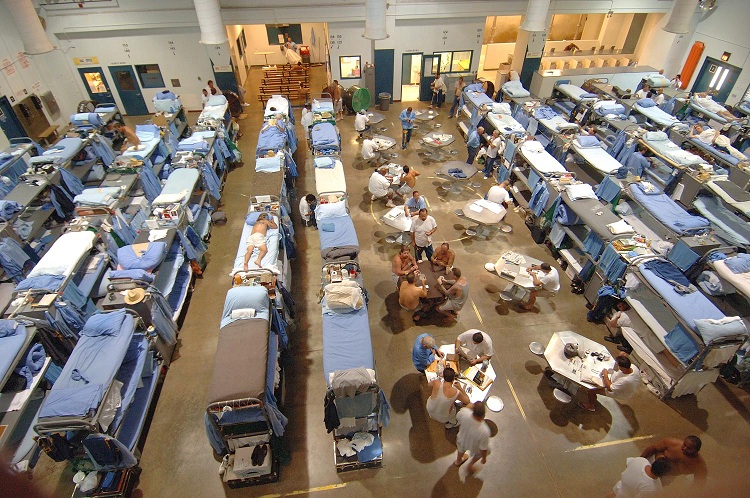
Living facilities in California State Prison, July 19, 2006. (California Department of Corrections, Wikimedia Commons)
Elephant in the Room: Pentagon Spending
In addition to the police and prisons, the other major source of American militarized spending is, of course, the Pentagon. That department, along with related activities like nuclear weapons funding at the Department of Energy, now gobbles up at least $750 billion per year. That’s more than the military budgets of the next 10 countries combined.
Just as prisons and policing consume a startling proportion of state and local budgets, the Pentagon accounts for more than half of the federal government’s discretionary budget and that includes most government functions other than Social Security, Medicare, and Medicaid. As Ashik Siddique of the National Priorities Project has noted, the Trump administration’s latest budget proposal “prioritizes brute force and militarization over diplomatic and humanitarian solutions to pressing societal crises” in a particularly striking way. “Just about every non-militarized department funded by the discretionary budget,” he adds, “is on the chopping block, including all those that focus on reducing poverty and meeting human needs like education, housing, labor, health, energy, and transportation.”
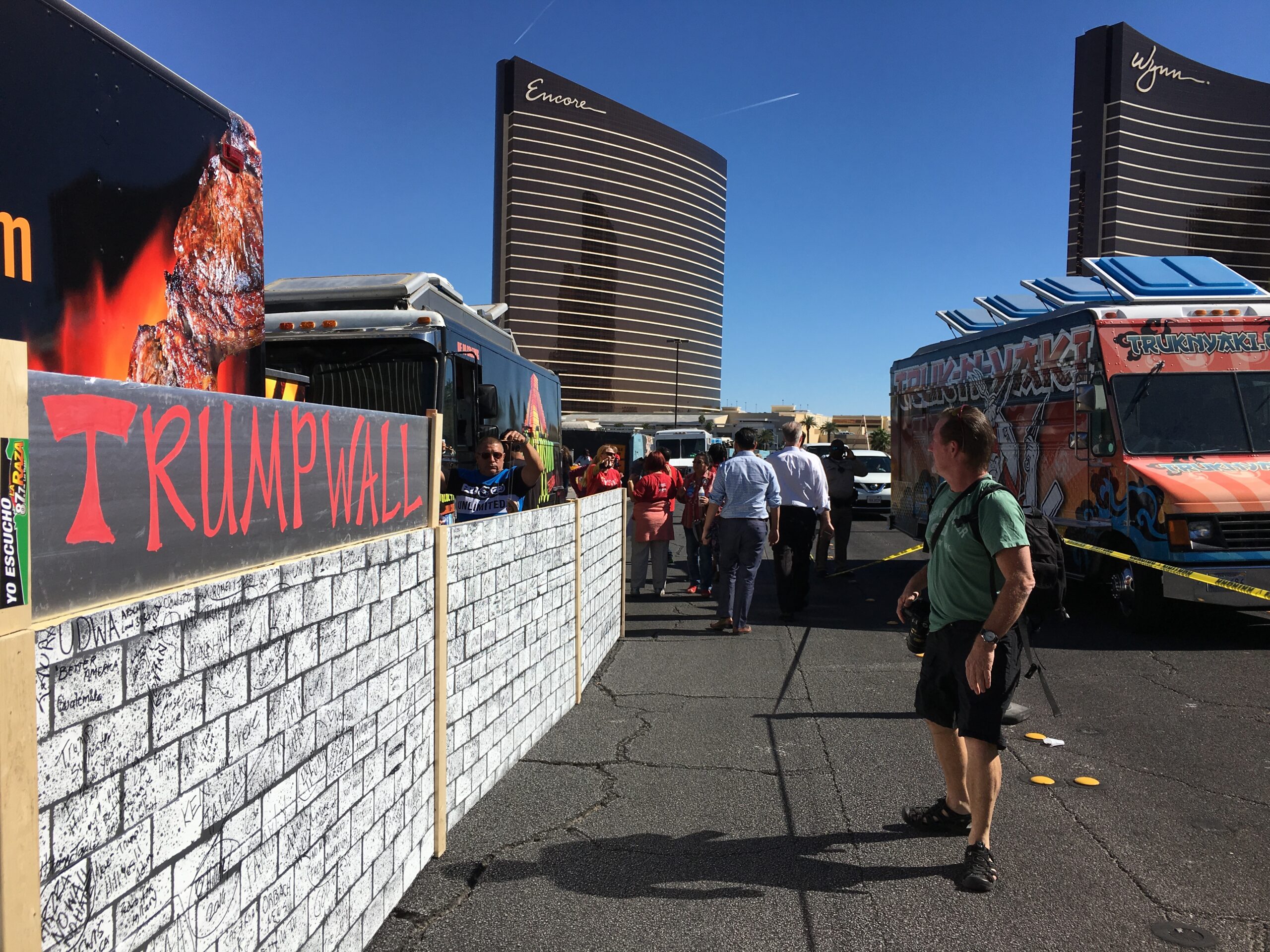
Taco trucks form the Wall of Tacos demonstration in front of the Trump International Hotel Las Vegas before the last 2016 U.S. presidential debate,Oct. 19, 2016. (Jessie Oni, Voice of America, Wikimedia Commons)
Spending on the militarization of the U.S.-Mexico border and the deportation of immigrants through agencies like ICE (Immigration and Customs Enforcement) and Customs and Border Protection totals another $24 billion annually. That puts U.S. spending on police, prisons, and the Pentagon at nearly $1 trillion per year and that doesn’t even include the soaring budgets of other parts of the American national security state like the Department of Homeland Security ($92 billion) and the Veterans Administration ($243 billion — a cost of past wars). Back in May 2019, Mandy Smithberger of the Project on Government Oversight and I had already estimated that the full national security budget, including the Pentagon, was approximately $1.25 trillion a year and that estimate, of course, didn’t even include the police and the prison system!
Another way of looking at the problem is to focus on just how much of the federal budget goes to the Pentagon and other militarized activities, including federal prisons, immigration enforcement, and veterans’ benefits. An analysis by the National Priorities Project at the Institute for Policy Studies puts this figure at $887 billion, or more than 64 percent of the federal discretionary budget including public health, education, environmental protection, job training, energy development, housing, transportation, scientific research, and more.
Making the Connection: The 1033 Program
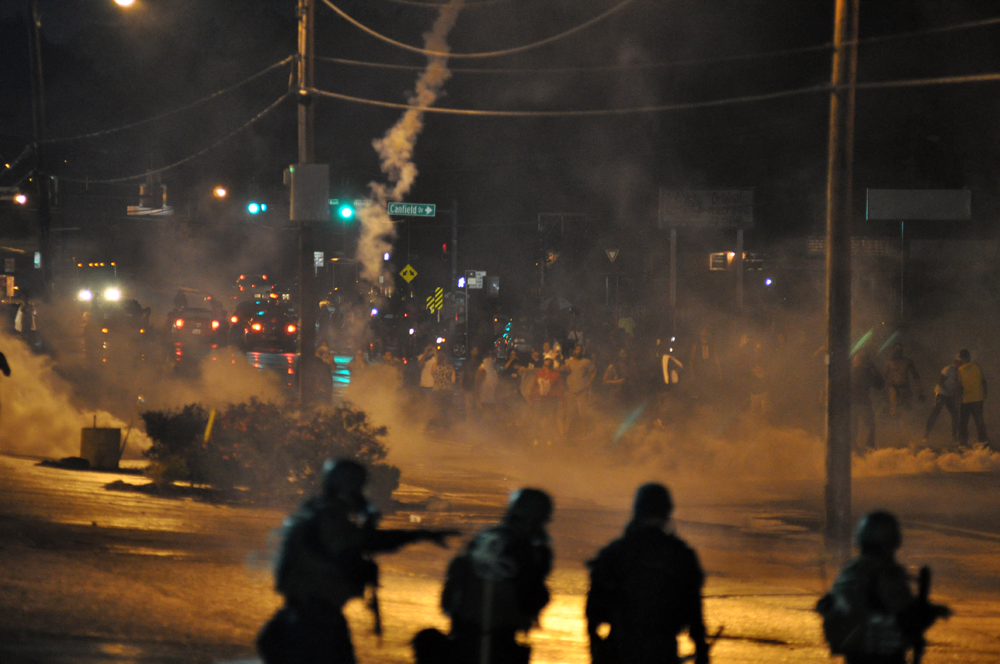
Black Lives Matter protests in Ferguson, Missouri, Aug. 17, 2014. (Loavesofbread, CC BY-SA 4.0, Wikimedia Commons)
Ever since images of the police deploying armored vehicles against peaceful demonstrators in Ferguson, Missouri, hit the national airwaves in 2014, the Pentagon’s program for supplying “surplus” military equipment to local police departments has been a news item. It’s also gotten intermittent attention in Congress and the executive branch.
Since 1997, the Pentagon’s 1033 Program, as it’s called, has channeled to 8,000 separate law enforcement agencies more than $7.4 billion in surplus equipment, including Mine-Resistant Ambush Protected (MRAP) vehicles of the kind used on the battlefields of Iraq and Afghanistan, along with rifles, ammunition, grenade launchers, and night-vision devices. As Brian Barrett has pointed out at Wired, “Local law enforcement responding to even nonviolent protests has often looked more like the U.S. Armed Forces.” Political scientist Ryan Welch co-authored a 2017 study suggesting, when it came to police departments equipped in such a fashion, “that officers with military hardware and mindsets will resort to violence more often and more quickly.”
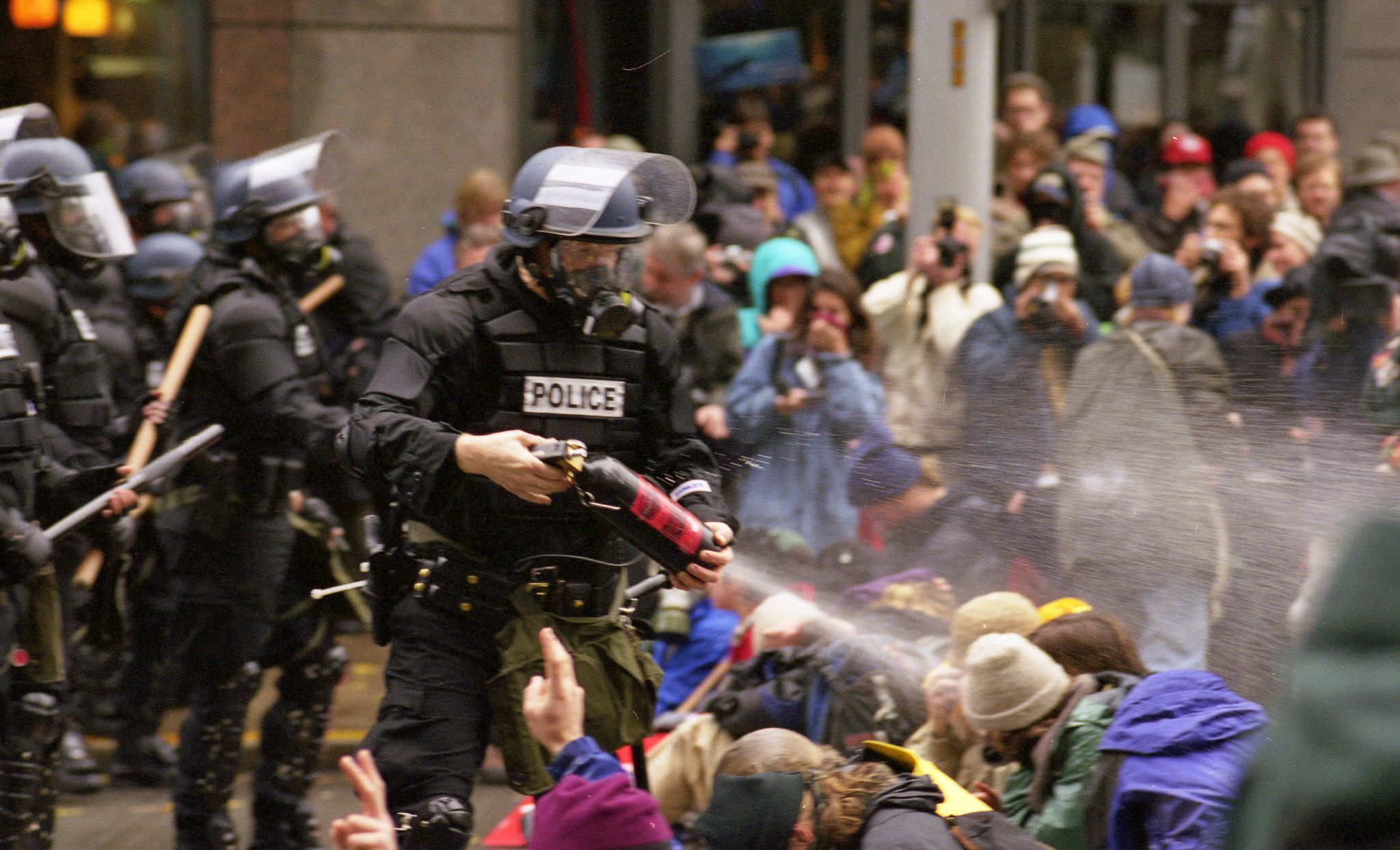
A riot policeman sprays pepper spray at seated protesters during the WTO protests in Seattle in 1999. (Steve Kaiser, CC BY-SA 2.0, Wikimedia Commons)
Under the circumstances and given who’s providing the equipment, you won’t be surprised to learn that the 1033 program also suffers from lax oversight. In 2017, the Government Accountability Office (GAO) created a fake law enforcement agency and was able to acquire $1.2 million worth of equipment through the program, including night-vision goggles and simulated M-16A2 rifles. The request was approved within a week of the GAO’s application.
The Obama administration finally implemented some reforms in the wake of Ferguson, banning the transfer of tracked vehicles, grenade launchers and weaponized aircraft, among other things, while requiring police departments to supply more detailed rationales describing their need for specific equipment. But such modest efforts — and they proved modest indeed — were promptly chucked out when Donald Trump took office. And the Trump administration changes quickly had a discernible effect. In 2019, the 1033 program had one of its biggest years ever, with about 15,750 military items transferred to law enforcement, a figure exceeded only in 2012, in the Obama years, when 17,000 such items were distributed.

Secret Service trainees practice executing a search warrant in a forced home entry. (U.S. Secret Service, Wikimedia Commons)
As noted, the mere possession of military equipment has been shown to stoke the ever stronger “warrior culture” that now characterizes so many police departments, as evidenced by the use of Special Weapons and Tactics (SWAT) teams armed with military weaponry for routine drug enforcement activities. It’s hardly just SWAT teams, though. The weaponry and related items provided under the 1033 program are widely employed by ordinary police forces. NBC News, for instance, reported that armored vehicles were used at least 29 times in response to Black Lives Matter protests organized since the murder of George Floyd, including in major urban areas like Philadelphia and Cincinnati. NBC has also determined that more than 1,100 Mine-Resistant Ambush Protected vehicles have been distributed to local law enforcement agencies under the MRAP program, going to communities large and small, including Sanford, Maine, population 20,000, and Moundsville, West Virginia, population 8,400.
A report from the American Civil Liberties Union (ACLU) has similarly documented the use of Pentagon-supplied equipment in no-knock home invasions, including driving up to people’s houses in just such armored vehicles to launch the raids. The ACLU concluded that “the militarization of American policing is evident in the training that police officers receive, which encourages them to adopt a ‘warrior’ mentality and think of the people they are supposed to serve as enemies, as well as in the equipment they use, such as battering rams, flashbang grenades, and APCs [Armored Personnel Carriers].”
Who Benefits?

President Donald Trump speaks to members of the National Security Council during a meeting at the Pentagon, July 20, 2017. (DoD, Amber I. Smith)
Companies in the military-industrial complex earn billions of dollars selling weapons, as well as building and operating prisons and detention facilities, and supplying the police, while theoretically dealing with problems with deep social and economic roots. Generally speaking, by the time they’re done, those problems have only become deeper and more rooted. Take, for example, giant weapons contractors like Lockheed Martin, Boeing, and Raytheon that profit so splendidly from the sales of weapons systems to Saudi Arabia, weaponry that, in turn, has been used to kill tens of thousands of civilians in Yemen, destroy civilian infrastructure there, and block the provision of desperately needed humanitarian assistance. The result: more than 100,000 deaths in that country and millions more on the brink of famine and disease, including Covid-19.
Such major weapons firms have also been at the front of the line when it comes to benefiting from America’s endless post-9/11 wars. The Costs of War Project at Brown University estimates that the United States has spent over $6.4 trillion on just some of those overseas conflicts since 2001. Hundreds of billions of those dollars ended up in the pockets of defense contractors, while problems in the U.S., left far less well funded, only grew.
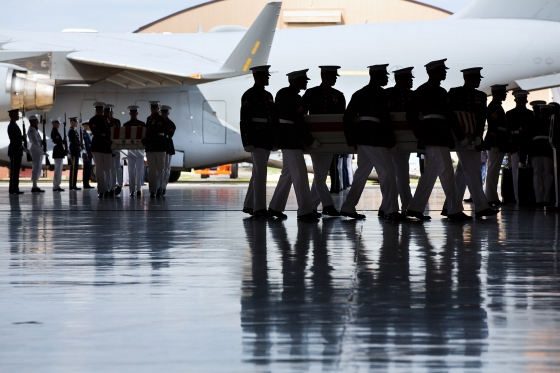
U.S. Marines at Joint Base Andrews, Maryland, on Sept. 14, 2012, carry caskets of four U.S. diplomatic personnel killed in an attack on the U.S. consulate in Benghazi, Libya. (White House, Pete Souza)
And by the way, the Pentagon’s regular budget, combined with direct spending on wars, also manages to provide huge benefits to such weapons makers. Almost half of the department’s $750 billion budget goes to them. According to the Federal Procurement Data System’s latest report on the top recipients of government contracts, the five largest U.S. arms makers alone — Lockheed Martin, Boeing, Raytheon, Northrop Grumman, and General Dynamics — split well over $100 billion in Pentagon awards among them in 2019. Meanwhile, those same five firms pay their CEOs a total of approximately $100 million per year, with hundreds of millions more going to other top executives and board members.
Meanwhile, in the Trump years, the militarization of the border has become a particularly lucrative business opportunity, with General Atomics, for instance, supplying ever more surveillance drones and General Dynamics supplying an ever more intricate and expensive remote sensor surveillance system. There are also millions to be made running privatized prisons and immigrant detention centers, filling the coffers of firms like CoreCivic and the GEO Group, which have secured record profits in recent years while garnering about half their revenues from those two sources.
Last but not least is the market for even more police equipment. Local forces benefit from grants from the Department of Homeland Security to purchase a wide range of items to supplement the Pentagon’s 1033 program.
The True Bottom Line
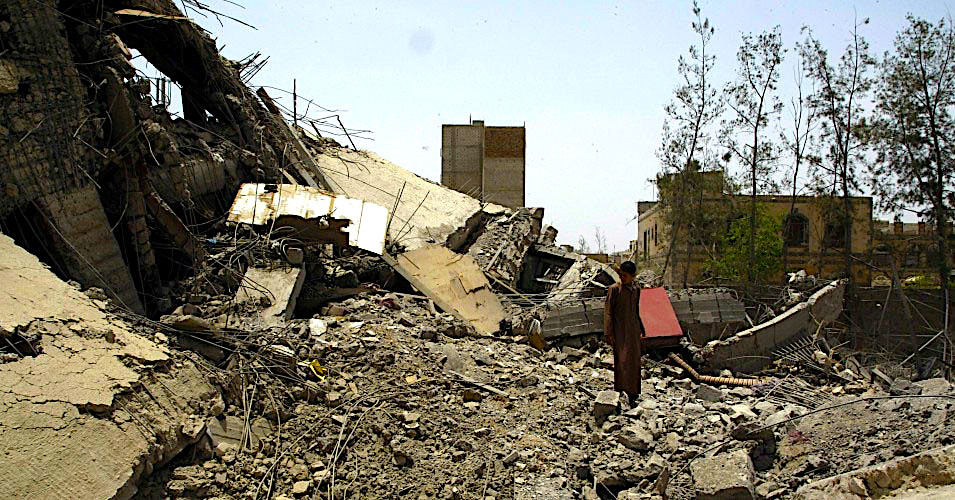
Yemen school bombed April 2019. (Flickr)
Much has been written about America’s failed post-9/11 wars, which have cost trillions of dollars in taxpayer treasure, hundreds of thousands of lives (American and otherwise), and physical and psychological injuries to hundreds of thousands more. They have also propped up sectarian and corrupt regimes that have actually made it easier for terrorist groups like al-Qaeda and ISIS to form and spread. Think of it as the ultimate boomerang effect, in which violence begets more violence, while allowing overseas terrorist organizations to thrive. As journalist Nick Turse has noted with respect to the militarization of U.S. Africa policy, the growth in American military operations on that continent has proceeded rather strikingly in conjunction with a proliferation of new terrorist groups. Put the best light on them and U.S. counterterror operations there have been ineffective. More likely, they have simply helped spawn further increases in terrorist activities in the region.
All of this has, in turn, been an ongoing disaster for underfunded domestic programs that would actually help ordinary Americans rather than squander their tax dollars on what passes for, but obviously isn’t, “national defense.” In the era of Covid-19, climate change, and an increased focus on longstanding structural racism and anti-black violence, a new approach to “security” is desperately needed, one that privileges not yet more bombs, guns, militarized police forces, and aircraft carriers but public health, environmental protection, and much-needed programs for quality jobs and education in underserved communities.
On the domestic front, particularly in communities of color, police are more often seen as an occupying force than a source of protection (and ever since the 1033 program was initiated, they’ve looked ever more like such a force as well). This has led to calls for defunding the police and seeking other means of providing public safety, including, minimally, not sending police to deal with petty drug offenses, domestic disputes, and problems caused by individuals with mental-health issues. Organizations like the Minneapolis-based Reclaim the Block have put forward proposals for crisis response by institutions other than the police and for community-based programs for resolving disputes and promoting restorative justice.
Shifting Priorities

On June 8, 2020, a police-free zone was established in the Capitol Hill neighborhood of Seattle. (Alex Glidewell, CC BY-SA 4.0, Wikimedia Commons)
Sharp reductions in spending on police, prisons, and the Pentagon could free up hundreds of billions of dollars for programs that might begin to fill the gap in spending on public investments in communities of color and elsewhere.
Organizations like the Movement for Black Lives and the Poor People’s Campaign are already demanding these kinds of changes. In its moral budget, a comprehensive proposal for redirecting America’s resources toward addressing poverty and away from war, racism, and ecological destruction, the Poor People’s Campaign calls for a $350 billion annual cut in Pentagon spending — almost half of current levels. Likewise, the platform of the Movement for Black Lives suggested a 50 percent reduction in Pentagon outlays. And a new youth anti-militarist movement, Dissenters, has called for defunding the armed forces as well as the police.
Ultimately, safety for all Americans will depend on more than just a shift of funding or a reduction in police armaments. After all, George Floyd and Eric Garner — just two of the long list of black Americans to die at the hands of the police — were killed not with high-tech weapons, but with a knee to the throat and a fatal chokehold. Shifting funds from the police to social services, dismantling police forces as they now exist, and creating new institutions to protect communities should be an essential part of any solution in the aftermath of Donald Trump’s presidency. Similarly, investments in diplomacy, economic assistance, and cultural exchange would be needed in order to help rein in the American war machine which, of course, has been attended to in ways nothing else, from health care to schooling to infrastructure, has been in this century. When it comes to both the police and the Pentagon, the sooner change arrives the better off we’ll all be. It’s long past time to defund America’s wars, both abroad and at home.
William D. Hartung, a TomDispatch regular, is the director of the Arms and Security Project at the Center for International Policy and the author of “Prophets of War: Lockheed Martin and the Making of the Military-Industrial Complex.”
This article is from TomDispatch.com.
The views expressed are solely those of the author and may or may not reflect those of Consortium News.
Please Contribute to Consortium
News on its 25th Anniversary
Donate securely with  PayPal here.
PayPal here.
Or securely by credit card or check by clicking the red button:

The article is depressing and very real. However I think conflating the carceral system with foreign wars and immigration reform is too much (I see the connections for sure, but they should be handled in several articles, in depth.) The initial increase in prison populations from the ’70s through about 1990 was due to increases in violent crime rate (probably more from demographics– too many young unemployed men– than from the War on Drugs). The doubling of the incarceration rate (effectively from one million to two million, where we are today) was political grandstanding by the Clintons/ Biden, happily supported by most Republicans and enough Democrats (who would NEVER have supported a similar bill to the 1994 Crime Bill with a NOMINALLY Republican President). By the late ’90s when implemented, the violent crime rate had fallen to 1960s levels and incarceration could not be justified (and yet persists today). All POOR people were/ are hit hard. Blacks in particular went from 1 in 12 men being “loser” felons to one in three (basically anyone in their society/ culture) where being incarcerated was the new normal. Along with no jobs (few hire felons), and a dragging down of their families and communities. This changed poor communities.
What to do? Incarceration should be only for violent offenders (and for white collar crimes that devastate communities). However I don’t see either political party taking money away from their donors’ private jails, being happy for the taxpayers to pay the exorbitant costs, and intentionally continue to destroy poor people’s lives, particularly the Black community.
Your comment describes the problem more accurately but fails in its solutions. It’s now well known that Michelle Alexander et al made a simple error in their analysis of the drive for mass incarceration: it was fuelled mostly by a real and enormous rise in violent offending, not solely racism and the war or drugs. Your call for only violent and undefined ‘white collar’ offenders to be imprisoned would reduce the numbers only by maybe 15%, as many drug offenders have a violent offence element in their sentence.
A truth that this article fails to recognise is that the USA’s response to the large increase in violent offences, committed mainly by young, Black men, during the 1960s-1980s, was economic in origin (as was, it seems, the rise in offending itself). Rather than, as most developed societies did, create a nation in which everyone’s basic needs are satisfied through an adequate welfare state, free health care and job-creation policies which inevitably cost a huge amount of government money to make and sustain, the USA decided to target its punitive and carceral response at the main offending communities: Blacks and poor whites. A large criminal justice sector for those communities is expensive but is much cheaper than a universal welfare state. Such a decision was supported by the left, centrists and the right, and by white and many Black political leaders. No-one wanted to be seen as soft on crime.
As yet, few Left activists or politicians seem to admit or even understand this essential part of US history and society. Until they do, progress will be small.
hXXps://jacobinmag.com/2020/03/mass-incarceration-racism-carceral-state-new-jim-crow/
hXXps://catalyst-journal.com/vol3/no3/the-economic-origins-of-mass-incarceration
If MRAP’s are being declared obsolete there may be planned obsolescence going on. The Air Force has bombers in service that are over 60 years old.
Obsolete armored vehicles should be sold to steel manufacturers for scrap. It is very hard steel of course. If a use can’t be found for it, stockpile it. Just stop giving the police the means of making war on the public. The police
should be required to show receipts scrapping their armored vehicles before getting federal funding.
By all means cut the military budget. Most of it should be called the imperial budget.
It’s as if someone handed Democrats/party loyalists a list of things to do to win elections, and they chose to do the exact opposite. While millions would be loath to admit it, our politics/politicians are a reflection of today’s America. Consider the absurdity of a self-described “left” that spent the past quarter century promoting middle class elitism within our capitalist system. When Americans rail about government expenditures, it’s not about the trillions of dollars thrown into our serial wars. It’s about whatever crumbs might still trickle down to the poor. As for the liberals, they’ve been on the brink of being “woke” since the Reagan ’80s. It just never quite happens.
Thank you for this piece – as you so aptly, truthfully write, Mr Hartung: “It’s long past time to defund America’s wars, both abroad and at home.” For the moral, ethical, physical, psychological, ecological, societal health for all peoples, domestically and internationally.
As I was reading this piece, I was asking myself the following questions:
a. How come there are SURPLUS armaments, military vehicles that the Pentagonal can so readily give them away to police departments around the country? Do the military industrialists (not a moral fiber to be found among the greed-ridden, murderous lot) require that the Pentagonal order far more of everything they produce than would ever be necessary even in the warmongering mindset in which the US military would seem to exist?
b. How come this country would seem to have so many people – in politics, industry, the military, the plutocracy – who are so psychopathic? Who are so amoral, unboundedly callous, so barbarous (no matter their pretty, expensive clothing), so avaricious that they care not in any way shape or form what their voting for, sucking up, using of the Pentagon’s obscene funding via ordinary taxpayer’s monies will lead to, cause here at home (ever increasing poverty, homelessness, poorer education, crumbling infrastructure, worsening health care) and the slaughter, destruction (physical and psychological) of lives, homes, livelihoods abroad??
c. And how is it possible for the “woke” (I imagine this is the present day equivalent, in meaning, of “hip”) to ignore totally the really existing fact that many among the Blue Faced Congressionals vote FOR these obscene Pentagonal funding bills. And then call any Blue Face “Left” wing? And then bully those among us who will not vote for either of the grotesqueries (or their VPs) because we refuse to choose ANY Evil, there being no such thing among the Red-Blue Faces as a Lesser one. These obscenities – all that Mr Hartung raises as examples of the Military-Police State, domestically and internationally – are the considered product of all our politicos in Congress and the WH, of BOTH Red and Blue Faces of the Janus Party.
c.